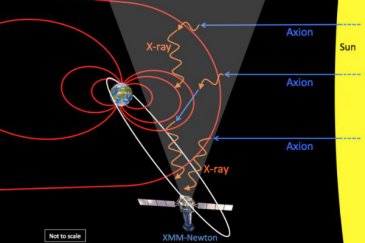Scientists have detected a mysterious X-ray signal that could be caused by dark matter streaming out of our Sun's core.
Scientists in the UK may have finally found direct evidence for dark matter pouring out of our Sun.
Dark matter is an invisible mass of unknown origin, that is believed to make up 85 percent of the Universe. But despite that, scientists have never been able to directly detect it - they only know it's there because of its gravitational effect on regular light and matter.
Now scientists at the University of Leicester have identified a signal on the X-ray spectrum which appears to be a signature of 'axions' - a hypothetical dark matter particle that's never been detected before.
While we can't get too excited just yet - it will take years to confirm whether this signal really is dark matter - the discovery would completely change our understanding of how the Universe works. After all, dark matter is the force that holds our galaxies together, so learning more about it is pretty important.
The researchers first detected the signal while searching through 15 years of measurements taking by the European Space Agency's orbiting XMM-Newton space observatory.
Unexpectedly, they noticed that the intensity of X-rays recorded by the spacecraft rose by about 10% whenever XMM-Newton was at the boundary of Earth's magnetic field facing the Sun - even once they removed all the bright X-ray sources from the sky. Usually, that X-ray background is stable.
"The X-ray background - the sky, after the bright X-ray sources are removed - appears to be unchanged whenever you look at it," said Andy Read, from the University of Leicester, one of the lead authors on the paper, in a press release. "However, we have discovered a seasonal signal in this X-ray background, which has no conventional explanation, but is consistent with the discovery of axions."
Researchers predict that axions, if they exist, would be produced invisibly by the Sun, but would convert to X-rays as they hit Earth's magnetic field. This X-ray signal should in theory be strongest when looking through the sunward side of the magnetic field, as this is where the Earth's magnetic field is strongest.
And that's exactly what the scientists found.
The research has now been published in the Monthly Notices of the Royal Astronomical Society. Sadly, the first author of the paper Professor George Fraser died earlier this year.
He writes in the paper: "The direct detection of dark matter has preoccupied physics for over 30 years … It appears plausible that axions – dark matter particle candidates - are indeed produced in the core of the Sun and do indeed convert to X-rays in the magnetic field of the Earth."
The next step is for the researchers to get a larger dataset from XMM-Newton and confirm the pattern they've seen in X-rays. Once they've done that, they can begin the long process of proving that they have, in fact, detecting dark matter streaming out of our Sun's core.
And that will take a lot of work, as physicist Christian Beck, who didn't work on the project, told Ian Sample from The Guardian. "A true discovery of dark matter that is convincing for most scientists would require consistent results from several different experiments using different detection methods, in addition to what has been observed by the Leicester group," said Beck.
If confirmed, it's hard to know just how profound the impact of this discovery could be.
"These exciting discoveries, in George's final paper, could be truly ground-breaking, potentially opening a window to new physics, and could have huge implications, not only for our understanding of the true X-ray sky, but also for identifying the dark matter that dominates the mass content of the cosmos," said Read in the press release.
Source: EurekAlert, The Guardian
